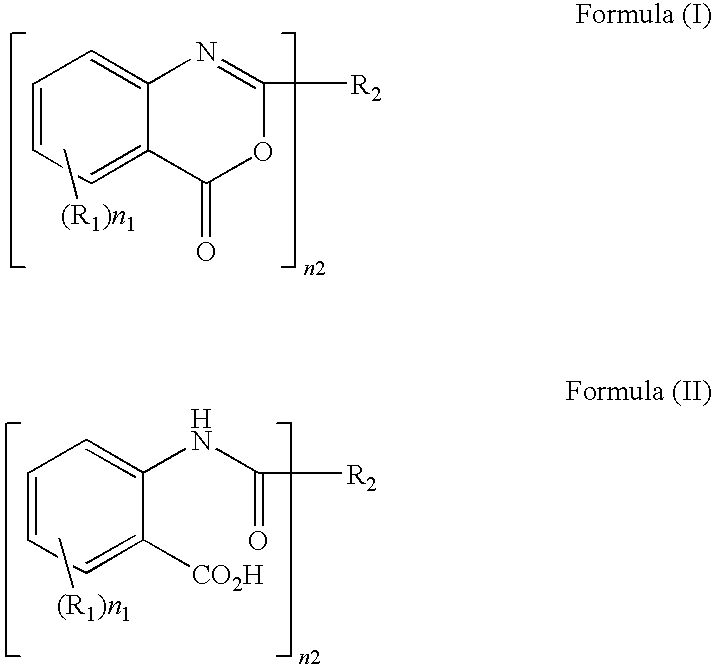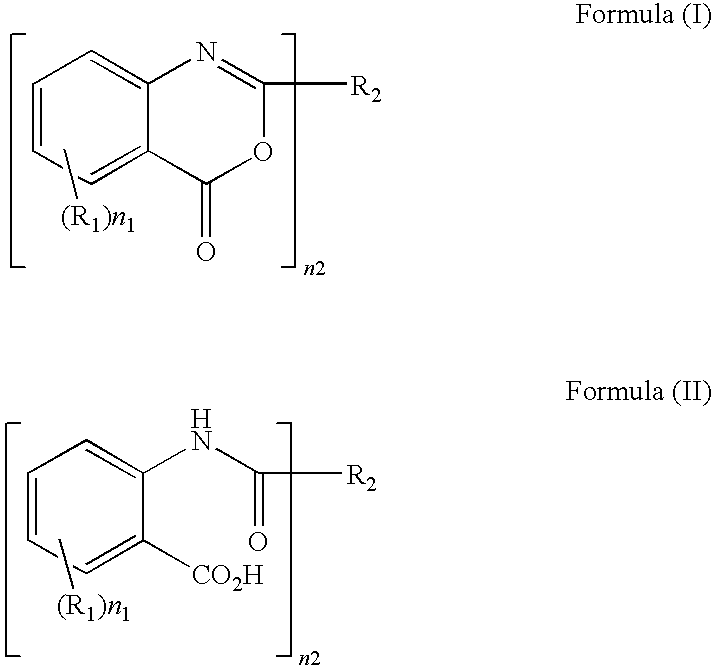Method of producing benzoxazinone-based compound
a technology of benzoxazinone and compound, applied in the field of thermoplastic polymer production method, can solve the problems of insufficient ultraviolet cut rate, insufficient heat resistance, and insufficient ultraviolet absorben
- Summary
- Abstract
- Description
- Claims
- Application Information
AI Technical Summary
Benefits of technology
Problems solved by technology
Method used
Image
Examples
example 1
Preparation of Exemplified Compound (I-7)
[0052]120.7 g of anthranilic acid and 1000 ml of N-methylpyrrolidinone were placed in a three-necked flask, and the mixture was dissolved while agitated. 89.3 g of terephthaloyl chloride (terephthalic dichloride) was added to the solution while agitated on ice, and the mixture was agitated additionally for 2 hours. The internal temperature was 3 to 8° C. at the time. Then, 225 g of acetic anhydride and 500 ml of N-methylpyrrolidinone were added thereto, the mixture was heated while stirred at an internal temperature of 108 to 116° C. for 2 hours and then cooled to 30° C. or lower; and the crystal obtained was filtered and dried, to give 155.6 g of a target exemplified compound (I-7) (yield: 96%). The content of sodium and potassium in the exemplified compound obtained (I-7) was 1 ppm or less. The lower detection limits for sodium and potassium are 1 ppm respectively, which is applicable to Examples 2 to 8.
[0053]Melting point: 317.3° C.
[0054]M...
example 2
Preparation of Exemplified Compound (I-7)
[0055]120.7 g of anthranilic acid and 1000 ml of N,N-dimethylacetamide were placed in a three-necked flask, and the mixture was dissolved while agitated. 89.3 g of terephthaloyl chloride was added to the mixture while the mixture was stirred continuously; the resulting solution was cooled in an ice-methanol bath; and the mixture was agitated additionally for 1 hour. The internal temperature was 0 to 5° C. at the time. Then, 225 g of acetic anhydride and 500 ml of toluene were added thereto; the mixture was heated and agitated under solvent reflux for 1.5 hours and then cooled to 30° C. or lower; and the crystal obtained was filtered and dried, to give 160.5 g of a target exemplified compound (I-7) (yield: 99%). The content of sodium and potassium in the exemplified compound obtained (I-7) was 1 ppm or less.
[0056]Melting point: 316.3° C.
[0057]Maximum absorption wavelength (λ max) in solution: 349.5 nm (toluene solution)
example 3
Preparation of Exemplified Compound (I-7)
[0058]120.7 g of anthranilic acid and 1000 ml of sulfolane were placed in a three-necked flask, and the mixture was dissolved while agitated. 89.3 g of terephthaloyl chloride was added to the solution while agitated on ice, and the mixture was agitated additionally for 2 hours. The internal temperature was 6 to 8° C. then. 225 g of acetic anhydride and 500 ml of dioxane were added thereto, the mixture was heated while agitated under reflux for 2 hours and then cooled to 30° C. or lower; and the crystal obtained was filtered and dried, to give 155.6 g of a target exemplified compound (I-7) (yield: 96%). The content of sodium and potassium in the exemplified compound obtained (I-7) was 1 ppm or less.
[0059]Melting point: 316.5° C.
[0060]Maximum absorption wavelength (λ max) in solution: 349.5 nm (toluene solution)
PUM
| Property | Measurement | Unit |
|---|---|---|
| temperature | aaaaa | aaaaa |
| donor number | aaaaa | aaaaa |
| temperature | aaaaa | aaaaa |
Abstract
Description
Claims
Application Information
 Login to View More
Login to View More - R&D
- Intellectual Property
- Life Sciences
- Materials
- Tech Scout
- Unparalleled Data Quality
- Higher Quality Content
- 60% Fewer Hallucinations
Browse by: Latest US Patents, China's latest patents, Technical Efficacy Thesaurus, Application Domain, Technology Topic, Popular Technical Reports.
© 2025 PatSnap. All rights reserved.Legal|Privacy policy|Modern Slavery Act Transparency Statement|Sitemap|About US| Contact US: help@patsnap.com



